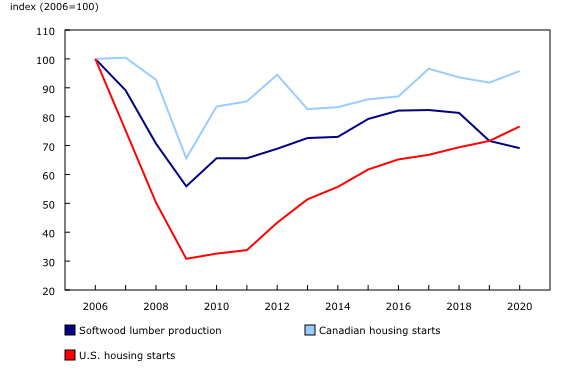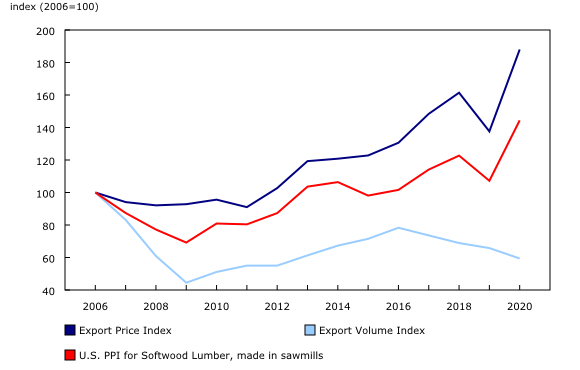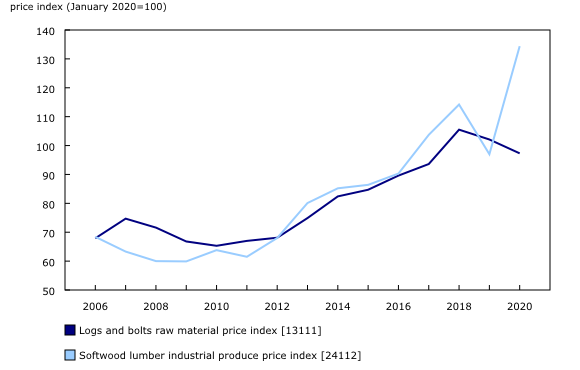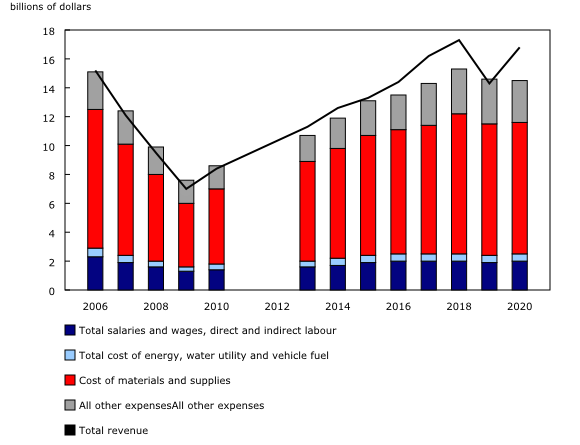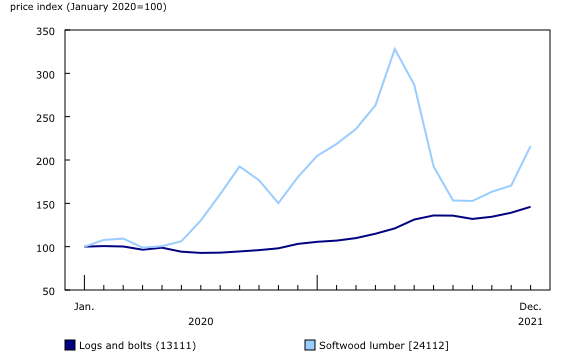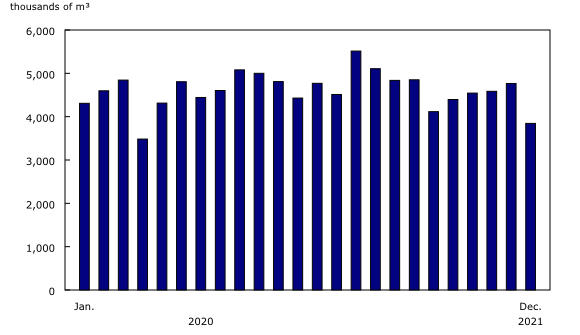Sawmill industry in Canada: 15 years in review
Released: 2022-07-11
The purpose of this research paper is to highlight the impact of the many challenges faced over time by the sawmill industry on its development and its role as an economic lever for many Canadian communities.
The sawmill industry produces softwood and hardwood lumber, as well as various by-products, such as wood chips and sawdust, that are used as inputs in other industries. Softwood lumber represented 98% of all lumber production in 2020.
As one of the world's largest producers and exporters of softwood lumber, demand for Canadian lumber is largely driven by U.S. imports. In 2020, 67% of Canada's softwood lumber production was exported, 84% of which was to the U.S.
Dimension softwood lumber is the main material used in home construction, whether it be for the framing and roofing of new housing or for rebuilding and renovating existing homes. Therefore, Canadian sawmills rely on growth in both the domestic and the U.S. housing markets to stimulate production and capital investment. Significant changes in the economic state of either country as well as in trade policy can affect the viability of the Canadian sawmill industry.
The forestry sector has had its share of challenges that have impacted the demand for lumber and the supply chain: the financial crisis in 2008/2009, trade conditions imposed by the U.S. on Canadian lumber imports, ongoing fibre supply challenges in western Canada due to wildfires, damage caused by mountain pine beetle, changes to land use regulations, as well as rail car availability issues. These challenges combined with the high cost of logs, pulpwood and other forestry products in recent years have led to a number of mills curtailing production in 2019, with some closing indefinitely. In 2020, the COVID-19 pandemic exacerbated market conditions with excess demand, resulting in skyrocketing lumber prices.
The role of the wood industry in Canada
Revenue from goods manufactured in the wood product industry contributed 5% to total revenue from goods manufactured in 2006, of which sawmill and wood preservation represented about half. In 2020, the wood product industry contributed 6% to revenue from goods manufactured of a value of $635.1 billion.
In 2020, the sawmill and wood preservation industry employed an annual average of 32,124 workers. Most likely driven by a modernization shift that impacted infrastructure, equipment and production processes, employment was down 41.0% (or 22,330 employees) compared with 2006, while employee productivity improved 17.2% over the same period.
In 2020, over three-quarters of sawmill and wood preservation industry workers were employed in British Columbia, Quebec and Alberta. When comparing 2020 with 2006, the average Canadian weekly earnings for the sawmill and wood preservation industry increased 44.4% to about $1,241, compared with a 27.7% increase seen for the manufacturing sector as a whole.
British Columbia, Quebec and Alberta produced 81% of Canada's softwood lumber in 2020. Since 2006, Alberta gained 8 percentage points of the Canadian market, while British Columbia lost 13 percentage points.
While sawmills (except shingle and shake mills) manufacturing is important to themany provinces' economies, it was the largest manufacturing industry in British Columbia in 2020, with a 12% share of the province's total revenue from goods manufactured. However, this represents a drop from 16% in 2006. Exports of softwood lumber accounted for 14% of British Columbia's total domestic merchandise exports in 2020.
Impact of the financial crisis
Most manufacturing industries were adversely impacted by the financial crisis in 2008/2009, with total revenue from goods manufactured in Canada falling 17.8% (-$106.6 billion) from 2007 to 2009. The impact was more severe for sawmills, with revenue from goods manufactured falling 40.3% (-$4.6 billion) over the same period.
Canada exported 44% of the total quantity of softwood lumber it produced to the U.S. in 2009, a 11 percentage-point reduction from 2007.
Demand for Canadian softwood lumber was significantly impacted in 2008-2009 due to sharp declines in Canadian and U.S. new housing starts.
In 2009, housing starts in Canada were at their lowest since 1999 (149,081 units). From 2009 to their latest peaks in 2017, softwood lumber production and new housing in Canada both trended upward. However, in 2020, both were still below pre-financial crisis levels.
U.S. total housing starts recorded a steeper decline, falling 69.2% from 2006 to 554,000 units in 2009, the lowest level since 1959. The market has been slowly recovering since 2009, as U.S. housing starts grew to reach 1,379,600 units in 2020. Canadian lumber production began contracting in 2017, even though housing starts were still increasing.
Impact of the expiration of the Softwood Lumber Agreement
While the U.S. has long been the largest importer of Canadian softwood lumber, their share fell 12 percentage points (to 70%) over the span of the most recent Softwood Lumber Agreement (2006 to 2015). During this period, Canada expanded to other markets, such as China.
The Softwood Lumber Agreement expired in October 2015 and, since then, the U.S. regained 14.0 percentage points of the share (to 84%) of Canada's $10.0 billion in exportations in 2020.
Although the demand for softwood lumber from the U.S. housing market has been gradually improving, and Canadian exportations to the U.S. have increased in dollar value, the quantity of lumber and other sawmill products exported to the U.S. has been steadily declining since 2016. According to U.S. Census Bureau data, the share of U.S. imports of softwood lumber from Canada had fallen 11 percentage points in 2020, mostly lost to the European Union.
The decrease in production of Canadian wood products was also reflected by the 10 percentage-point drop in the average industrial capacity utilization rate for wood product manufacturing from 2016, down to 78% in 2020.
Canada's export prices have grown 87.9% over the past 15 years, while U.S. domestic prices have risen by 44.4% over the same period.
The impact of the wildfires
Wildfires in the West have also had a significant impact on the log supply. According to British Columbia Ministry of Forests, Lands, Natural Resource Operations and Rural Development, about 2.5 million hectares were destroyed in British Columbia in 2017/2018.
The interior region accounted for 89% of the province's softwood lumber production in 2018.
With softwood lumber production in British Columbia interior region down 5.8% from 2016 to 2018, and high lumber prices (particularly in 2018), the reduction of timber due to the wildfires contributed to the growth in stumpage rates in 2018. Stumpage is a fee that businesses and individuals pay to harvest timber on Crown land.
Wildfires in Alberta were also a reality, with more than 883,000 hectares of land destroyed in 2019 (according to Alberta Wildfire). The total area burned, most by the end of May, far exceeded the nine-year seasonal average.
From the forest to the customer, the lumber supply chain is a complex business network that can affect wood products availability and price.
As the majority of Canada's forests (approximately 94% according to National Resources Canada) are publicly owned, businesses and individuals pay stumpage fees to harvest timber on Crown land. Stumpage rates vary by province, even among regions within a province and are based on current market lumber prices and adjusted to reflect market conditions.
The supply chain can also be impacted by the logistics of getting the logs from forest to sawmill, getting the lumber from sawmill to distributor, and then getting from distributor to consumer. In 2020, 61% of Canadian lumber was shipped by rail, so any disruption due to weather, strikes, blockades or shortages of railcars can impede getting lumber to the market and to the consumer.
A challenging context for profitability
The sawmill industry generally does not generate large profit margins. In 2016, when the one-year grace period of the Softwood Lumber Agreement ended, sawmills (except shingle and shake mills) spent 93 cents in total expenses for every dollar of total revenue. Revenue from goods manufactured accounted for 96% of total revenue. In 2019, spending exceeded earnings as total expenses rose to $1.02 per dollar of total revenue. The year 2019 had proven to be an extremely difficult year, mainly due to the mix of high log prices and lower market prices for dimension lumber.
A spike in domestic and export softwood lumber prices in 2020, combined with a decrease in log and bolt prices, improved the profitability of sawmills to 87 cents spent for every dollar earned.
The cost of materials and supplies is the biggest expense of the sawmill industry. It is made up of purchases of raw material and components, repairs and maintenance, payments to subcontractors, and stumpage fees. In 2020, Canadian sawmills spent 54 cents for every dollar earned on the cost of materials and supplies, a 9 cent drop from 2019.
The impact of the pandemic
The impact of the pandemic has been relentless on the sawmill industry, with on-and-off lockdowns since March 2020. Demand for lumber continued to outpace supply, following a reduction in production capacity in 2019. With a significant portion of the population still working from home in 2021, many consumers have turned to home renovations and improvements, putting pressure on the limited lumber supply.
This increased consumer demand led to softwood lumber prices that skyrocketed in June 2020 and that peaked in May 2021.
Not only have home renovations been on the rise, but housing starts grew 30.3% (+63,197) since 2019, up to 271,882 in 2021. In fact, Canada recorded its highest first quarter level in 2021 since the inception of the series in 1948.
Since 2019, wholesale revenue of lumber, millwork, hardware and other building supplies recorded a 46.9% (+$24.8 billion) increase to reach $77.6 billion in 2021.
Retail sales of lumber and other renovation materials and supplies followed a similar trend, increasing 45.0% (+$6.8 billion) to reach $22.0 billion in 2021.
Note to readers
Totals may not add up due to rounding.
The Softwood Lumber Dispute: The U.S. lumber industry has frequently sought to restrict imports of Canadian softwood lumber, citing unfair competition. These restrictions have been done through the application of U.S. countervailing and antidumping duty laws.
For more information on the Softwood Lumber Agreement and the Softwood Lumber Dispute, please visit the Global Affairs Canada website.
Contact information
For more information, or to enquire about the concepts, methods or data quality of this release, contact us (toll-free 1-800-263-1136; 514-283-8300; infostats@statcan.gc.ca) or Media Relations (statcan.mediahotline-ligneinfomedias.statcan@statcan.gc.ca).
- Date modified:

